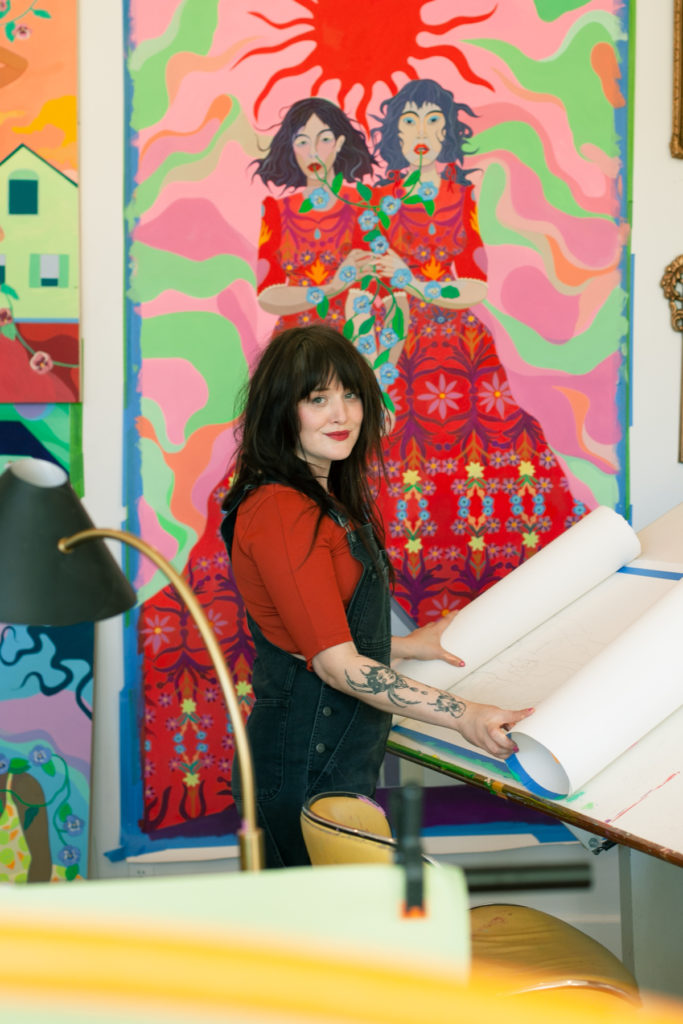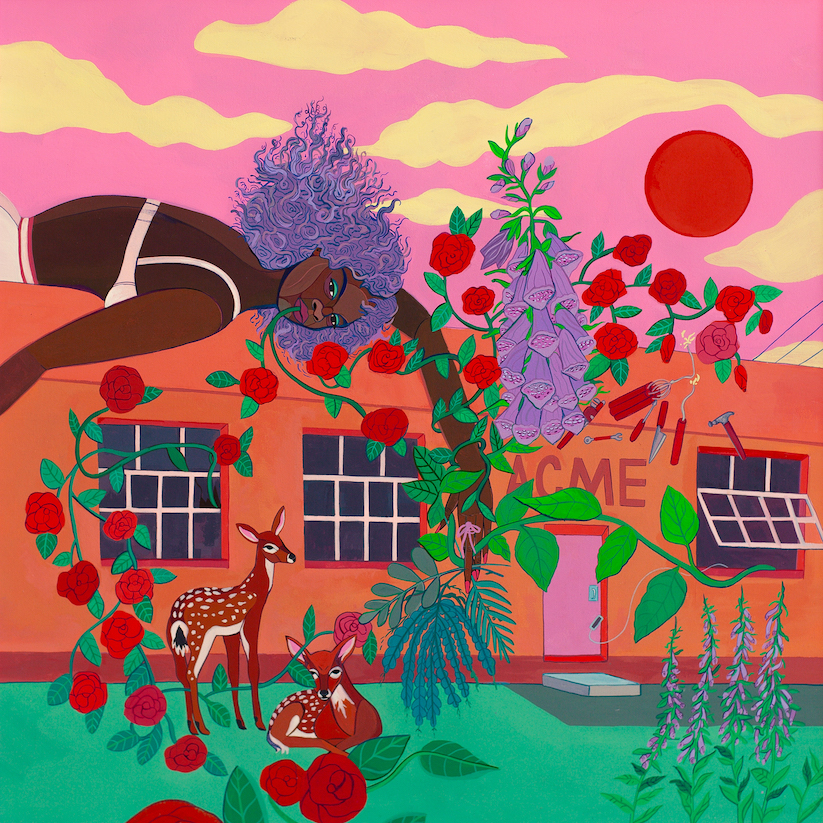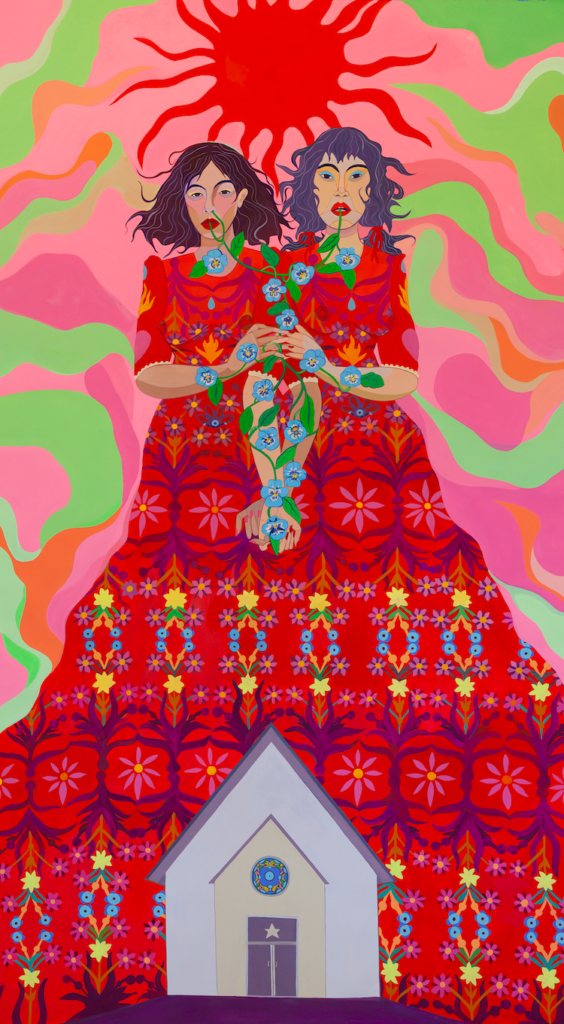Painting through the Pain: Meg Lionel Murphy
- Share
- Tweet
- Pin
- Share

The giant-empowered art of Meg Lionel Murphy
Seen from across a gallery, Meg Lionel Murphy’s paintings look joyful.
Her canvases are splashed with brilliant colors depicting lovely women, often naked or in fairly transparent attire; brightly painted foliage; and little knights on horseback set against large female figures who may also be holding John Deere tractors or the occasional Navy ship.
These are fun fantasy figures – until you move closer. That’s when you see the pained expressions, the cascades of tears, paint flowing from mouths and breasts.
Murphy says she is recovering from domestic violence and still has PTSD (post-traumatic stress disorder).
Her work mostly presents women, but she does show on Instagram a painting of a man seen through a window as he chokes a bare woman. The view includes a window flower box. Her text that accompanies the picture says: “I don’t love today. But I love the you that escaped the grip of a dangerous man.”

On her website, Murphy shares other pieces in the series. In one, the man is swinging what looks like a lamp base at the woman, and another shows him punching her. In the last, she is sitting on a bathroom floor, alone, with a tree.
Murphy’s work is in the Ten at Ten show through April 9 at the Museum of Wisconsin Art in West Bend.
Ally Wilber, curator of public programs at the museum, credited the Miller Art Museum’s executive director, Elizabeth Meissner-Gigstead, with bringing Murphy to her attention last year.
“We came up with the idea of highlighting emerging artists; we haven’t seen Meg’s work displayed much in this area,” Wilber said. “Conceptually and aesthetically, it fits with a recurring theme in the group, which is world building. Meg creates this universe where women are lifting each other up and growing into these exquisite giantesses.”
Wilber said she’s buying one of Murphy’s paintings for her own collection, and the museum will do a one-woman show of Murphy’s work next year at its downtown-Milwaukee site.
Murphy said she paints on a timeline that began about eight years ago, but that doesn’t mean she’s working chronologically.
“I’m constantly jumping back and forth in it,” she said. “So one painting will be when the women are small and vulnerable inside a room. Maybe there’s an act of violence happening in one. Another painting will be a euphoric example of a giant toppling a house, and then the giants gather together in a field, almost becoming part of the landscape.”
The paintings are all related to her, Murphy said. They tell a story, almost like frames in a comic book or graphic novel.
“It is very narrative driven, like a world being built,” she said, “and I think it would be so lovely to continue my whole life with this and see where it goes, because it does seem like one painting leads to the next painting. I recently have been commissioned to go back to a different part of the timeline, which is what I am focusing on right now.”
How does a patron describe the point on Murphy’s timeline that the patron wants her to revisit for a painting?

“It’s where the giants are so big they cannot fit in their homes anymore,” she said. “Because there’s no home, they themselves become the landscape, and their bodies, when I paint them, look like the hills or the land. And there is a battle scene at that point with men on horseback – soldiers – who are coming to tame this land. But the battle scenes are hopeful because the giants are so much bigger than the soldiers.”
Those paintings sell quickly, Murphy said. She is excited by the commission because it breaks into her obsession with a later part of the timeline that she had been working on.
“Healing from PTSD isn’t linear, of course,” she said. “You’ll get so far, and then maybe get triggered, and you’re on your way back to square one, and you have to build yourself back to healing.”
One painting, titled “Safe Space,” was made for Traumatica Dramatica, Murphy’s solo show at The Untitled Gallery in Manhattan’s Tribeca neighborhood during the summer of 2021. The painting resides in a delicious, frosty-pink frame and shows a woman draped over a one-story building. Her wild, purple hair nearly matches the purple foxglove flowers draped from the roof. A solid, red sun and wavy, yellow clouds fill a pink sky while a couple of fawns hold the foreground.
“On my timeline right now, I’ve been really focused on almost psychedelic medieval war scenes – really, battle scenes,” Murphy said. “Before, the women were dressed; now they are the monsters themselves. As they grow into this more medieval state, I’ve had so much fun imagining a medieval time overlapping our modern time along my timeline. So I just keep reaching and reaching and reaching to push my work into a more magical world, and writing that world with every painting.
“I hope to write this timeline until I die,” she continued. “I do a lot of research. I read a ton of books – books about everything from medieval culture, medieval arts, what gender meant in the medieval era, what different myths were interesting in the medieval era, the history of religion, the role that wine played back then.”

Murphy thinks her work has made her spiritual, but not necessarily religious.
“I was raised very, very, very Catholic, and I loved it,” she said. “Then I went through a very intense atheist period for a very long time. And I think that my painting somehow is – maybe more spiritual. I’m still figuring it out.
“I’m obsessed with this moment of transformation, the moment where you want to leave, you need to grow out of your home, education. The idea that you need to leave and you need to grow.”
Murphy grew up in Sturgeon Bay and then moved to Minnesota, where she earned degrees in art, art history and English literature from the University of Minnesota-Twin Cities. She loves school and might consider a master’s degree, except that she can’t decide on the area she wants to study.
“I already have my painting practice, which I feel good about. I think what I want are the connections and the access to research – their libraries, their history departments, their writing departments. I actually am more interested in the art history and literature side of an M.F.A., so it would have to be the right program,” she said. “And I’m really skeptical of the cost and also the way it seems to change people’s art.”
Murphy returned to Sturgeon Bay from Portland, Oregon, after her grandmother died and she realized she missed her family.
“There were many reasons I came back, but that was one,” she said. “I just realized that I really enjoyed being by my family. I do. And they’re very supportive. They may not love every painting, but they have always been extremely supportive of me making my work.”
Murphy said she has about 17 things she’s working on right now.

“I’m expecting lots of beds, lots of drapes, lots of interior design,” she said. “I use at least one prop for every painting, so we have lots of doll houses, doll-house furniture. Lots of little tchotchkes from Bayside Bargains. I go there almost every day and collect things, and I put them into my work.”
She also does a lot of research on interior design and the way women make their homes.
“I know when I was in a bad situation, I was constantly trying to make my home safer,” she said.
Murphy’s paintings frequently show bathroom fixtures such as toilets, bathtubs and sinks – a reflection of her experience with domestic violence, when the bathroom was the only room in the house with a lock on the door.
Her favorite symbols include animals – lions, tigers, bears – but also smartphones.
“That’s just like a trope which I think is fun. My middle name is Lionel, so I like lions,” Murphy said. “Cell phones, of course, just bring it back to that modern space, and also a sense of possibility in a world within a world. It’s so interesting that you can put a cell phone in a painting, and that’s a whole world in a painting. It’s amazing to me. Those are magic – it’s such a powerful symbol. But they need plugs. I put a lot of cell-phone chargers in my work, but I don’t think anyone ever noticed them.”

